Article
Wildlife Photography
in October
Autumn is now in full swing and a look in
any tree lined street, out in the countryside, amongst our woodlands and
arboretum you will see a wealth of colours from yellows, gold's, oranges,
reds and of course some greens. In some areas the change in temperature is
now starting the process of trees loosing their leaves, so you need to get
out in the next couple of weeks if you want to capture the autumn colours,
see our
Autumn Colours
 area for how to go about doing this, lists of places you could visit and
location guides on some. Whilst out in the woods keep a look out for
squirrels
area for how to go about doing this, lists of places you could visit and
location guides on some. Whilst out in the woods keep a look out for
squirrels
 and jays as they scurry about on the ground
burying their stash of hazel nuts and acorns which are now ripening, ready
for their winter store.
Red squirrels and jays as they scurry about on the ground
burying their stash of hazel nuts and acorns which are now ripening, ready
for their winter store.
Red squirrels
 undergo their autumn moult and replace their worn coats with one of the
deepest red chestnut, their tails begin to fill out and they complete the
cute package with their little tufty ears. To watch the hectic foraging you
will find clusters of these in the UK in places such as
Formby Point
undergo their autumn moult and replace their worn coats with one of the
deepest red chestnut, their tails begin to fill out and they complete the
cute package with their little tufty ears. To watch the hectic foraging you
will find clusters of these in the UK in places such as
Formby Point
 on the Lancashire coast and in
Kielder Forest,
on the Lancashire coast and in
Kielder Forest,
 Northumberland.
Northumberland.
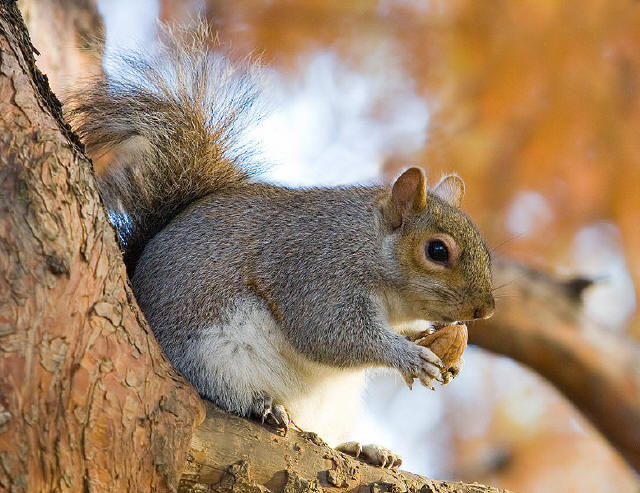 
Grey Squirrel with Acorn


October is a special time for our largest
native land animal, the
Red
Deer, as this is the start of the rut. The
males fight it out to be in control of a group of 10 to 20 females which he
can mate with. During the summer he has been growing a complete new set of
impressive antlers, having lost the old ones in the spring, they go through
a number of growing stages including a velvety covering before they are
fully hardened and ready for battle. They use these and their newly acquired
body weight and bellowing to impress the females, using their antlers only
when necessary to fight off an intruding male. Red Deer can be found in
Scotland and some of our
National Parks as this is the start of the rut. The
males fight it out to be in control of a group of 10 to 20 females which he
can mate with. During the summer he has been growing a complete new set of
impressive antlers, having lost the old ones in the spring, they go through
a number of growing stages including a velvety covering before they are
fully hardened and ready for battle. They use these and their newly acquired
body weight and bellowing to impress the females, using their antlers only
when necessary to fight off an intruding male. Red Deer can be found in
Scotland and some of our
National Parks
 such as
Dartmoor, such as
Dartmoor, Exmoor and the New Forest, but take a look at our
Deer Section Exmoor and the New Forest, but take a look at our
Deer Section
 for places you might want to try. It is also the rutting season for
Fallow Deer,
for places you might want to try. It is also the rutting season for
Fallow Deer,
 a much smaller breed, but the stags are still
just as impressive with their large antlers and light spotty backs. a much smaller breed, but the stags are still
just as impressive with their large antlers and light spotty backs.
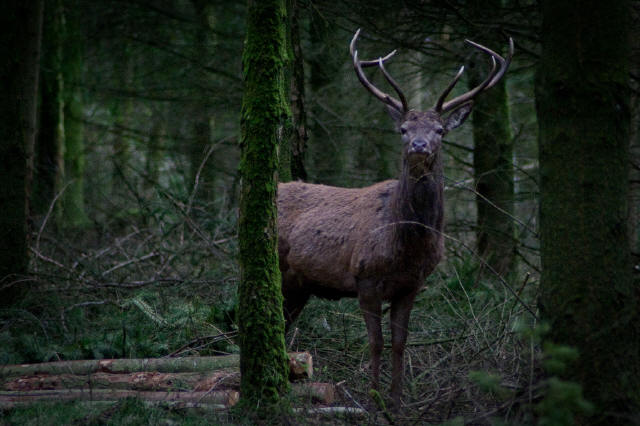 
Red Deer Stag by
Mark Robinson


Woodlands and
Forests
 are a place to visit not only for the autumn colours on the trees, or the
colourful carpets of leaves on the woodland floor but also for this months
speciality, fungal fruiting bodies. Many of the different types of fungi
will be covering the woodland floor, taking route in old fallen trees, in
tree bark and other such moist places and getting ready to disperse their
seeds. Fungi play an important role in the circle of life of plants and
trees, their part is to break down organic matter i.e. dead leaf litter,
dead animals etc and help the process of recycling. They also help plants to
access the nutrients they need to grow and thrive. The Red top with white
spots of the Fly Agaric which can be found around birch or sitka spruce
tress are attractive to photograph, but beware DO NO TOUCH as they are
poisonous. Or watch out for the black and white of the Shaggy Inkcap also
known as the 'Laywers Wig' they can appear in lawns overnight. These are
just two of the species you may come across.
are a place to visit not only for the autumn colours on the trees, or the
colourful carpets of leaves on the woodland floor but also for this months
speciality, fungal fruiting bodies. Many of the different types of fungi
will be covering the woodland floor, taking route in old fallen trees, in
tree bark and other such moist places and getting ready to disperse their
seeds. Fungi play an important role in the circle of life of plants and
trees, their part is to break down organic matter i.e. dead leaf litter,
dead animals etc and help the process of recycling. They also help plants to
access the nutrients they need to grow and thrive. The Red top with white
spots of the Fly Agaric which can be found around birch or sitka spruce
tress are attractive to photograph, but beware DO NO TOUCH as they are
poisonous. Or watch out for the black and white of the Shaggy Inkcap also
known as the 'Laywers Wig' they can appear in lawns overnight. These are
just two of the species you may come across.
Within your garden, if you put out winter
feeds for the local birds, Robins will be coming back to take their fill and
keep them going through the winter months, and greenfinches will flock to
get their share. If you are lucky enough to live the in right country
location you may also see
Redwings
 who have migrated here from Scandinavia, Russia and Iceland to enjoy our
warmer winter. Also look out for the
FieldFare
who have migrated here from Scandinavia, Russia and Iceland to enjoy our
warmer winter. Also look out for the
FieldFare
 and other winter thrushes as they arrive from
their breeding grounds and feast on berries in the hedgerow, and fallen
fruits such as apples. So don't have the urge to tidy your garden over this
period, fallen fruit, leaf litter and the like provide good feeding grounds
for birds, insects and other winter wildlife, and you will be surprised at
what visits you. Another garden visitor and is very prevalent in my garden
this year is the spider. There are cobwebs everywhere and getting to see
these in the early morning when the dew is still upon them gives photo
opportunities in abundance, the only problem usually is the background as
they are not fussy on where they create them. Another effect is the capture
of flying seeds as they travel to new resting grounds and get caught in the
spiders web, not much of a meal for a spider, but a pretty photo. and other winter thrushes as they arrive from
their breeding grounds and feast on berries in the hedgerow, and fallen
fruits such as apples. So don't have the urge to tidy your garden over this
period, fallen fruit, leaf litter and the like provide good feeding grounds
for birds, insects and other winter wildlife, and you will be surprised at
what visits you. Another garden visitor and is very prevalent in my garden
this year is the spider. There are cobwebs everywhere and getting to see
these in the early morning when the dew is still upon them gives photo
opportunities in abundance, the only problem usually is the background as
they are not fussy on where they create them. Another effect is the capture
of flying seeds as they travel to new resting grounds and get caught in the
spiders web, not much of a meal for a spider, but a pretty photo.
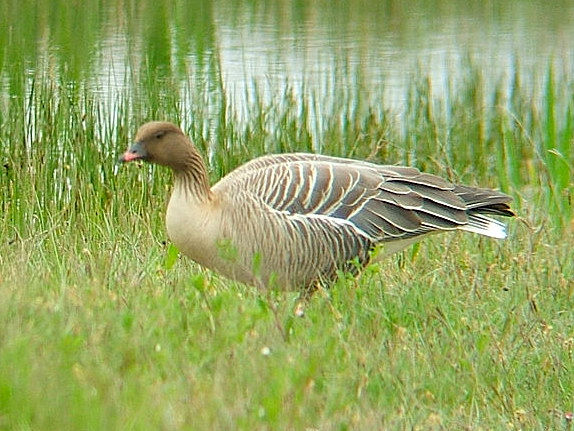
Pink Footed Goose


On the bird front migration for most birds
that have been here through the summer months is coming to an end, you may
still see some warblers and house martins, but most will have returned by
the end of the month. On the other hand the big migration of
Winter Migrants
 such as swans and geese that visit us during
the winter months is in full swing, with the Wildfowl and Wetland Centres
around the UK starting to fill up with
Bewick's Swans such as swans and geese that visit us during
the winter months is in full swing, with the Wildfowl and Wetland Centres
around the UK starting to fill up with
Bewick's Swans
 arriving at
Slimbridge arriving at
Slimbridge
 in Gloucestershire and
Arundel in Gloucestershire and
Arundel
 in Sussex, while the
Whooper Swans in Sussex, while the
Whooper Swans
 and
Barnacle Geese and
Barnacle Geese
 flock into
Caerlaverock flock into
Caerlaverock
 in Scotland,
Pink Footed Geese in Scotland,
Pink Footed Geese
 arrive at
Martin Mere arrive at
Martin Mere
 in Lancashire and
Brent Geese
in Lancashire and
Brent Geese
 make their winter home on
Strangford Loch make their winter home on
Strangford Loch
 in Northern Ireland. Our Estuaries are also
filling up with more waders and wildfowl, such as the red beaked, tufted
headed Merganser which can be found in small flocks along the east and south
coast as well as in the Bristol Channel. Starlings gather in large groups
on treetops and telephone wires before joining up with other large groups in
large roosts in woodland. Some of the best starling displays are seen at
dusk as them come to roost for the night. in Northern Ireland. Our Estuaries are also
filling up with more waders and wildfowl, such as the red beaked, tufted
headed Merganser which can be found in small flocks along the east and south
coast as well as in the Bristol Channel. Starlings gather in large groups
on treetops and telephone wires before joining up with other large groups in
large roosts in woodland. Some of the best starling displays are seen at
dusk as them come to roost for the night.
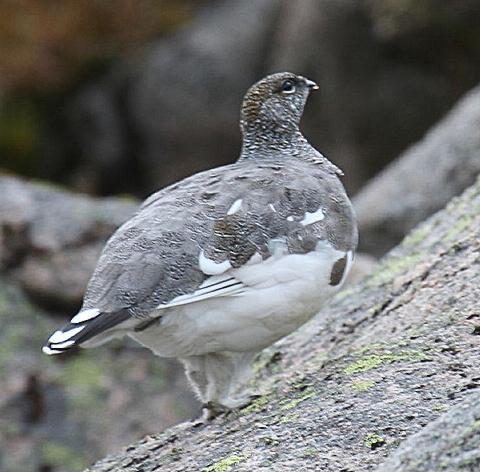 |
Bats will be more visible in the dusk skies, with frantic activity in
collecting enough food to keep them going through the winter hibernation. Badgers will also be out and
about looking for enough food to fatten themselves up for ready for winter,
although they do not hibernate they do need to get ready for winter when
there is less around for them to feast on. Our mountains and uplands have been home
through the summer to breeding waders and summer migrants, now they are
being left to our native species such as the grouse, ptarmigan and mountain hares.
The dawn and dusk period is not only a busy
time for bats and birds, but also for foxes, as the days start to
get shorter there are opportunities to catch sight of them as the afternoon
light fades. They have just finished their summer moult and are in pristine
condition with glossy red coats and fluffy bushy tails at this time of year.
They are out trying to fatten up ready for winter and will be looking for
small mammals and hedgerow fruits. |
|
Ptarmigan by
Alistair Rae

 |
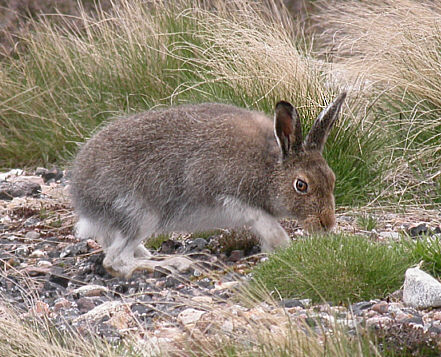  The Mountain Hare
The Mountain Hare
| In the plant world, most of the colourful
floral displays of the summer months is coming to an end, and many will be
out in their gardens tidying up and planting winter varieties. Our hedgerows
will contain some colourful fruits and berries such as the rosehip, which attract the birds, but
our road verges and even meadows and grassland will have been mown and
starting to be grazed until Autumn is out. However one plant that is a
prominent during Autumn and Winter is the Ivy, being an evergreen they
provide a very important role during this period. Their life cycle is out of
step with other British plants flowering in the autumn and having fruit in
the spring, for this reason they provide an important food source for
hibernating insects who can feed on their nectar. It also provides shelter
for insects and birds when they need it most. The Holly Blue butterfly
relies on Ivy as a breading ground for their offspring, they lay the
white, dimpled, disc shaped eggs on the Ivy flower stalk, green
caterpillars hatch and |
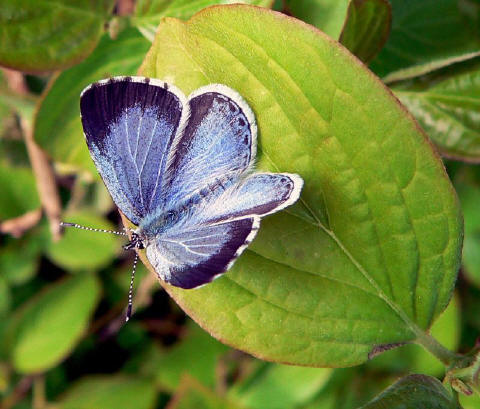
 Holly Blue Butterfly by
Mark Robinson
Holly Blue Butterfly by
Mark Robinson

 |
feed on the buds,
they then spend their winter as a chrysalis hidden in the ivy foliage ready
for the adults to emerge next April.
So Autumn should not be a time to think
about putting away your camera, but should be a time to get out and capture
what you can, even if a little more challenging. However if you achieve it
you will be delighted you made the effort to take time out with our
wildlife.
|
Share your wildlife
photos
Let us expand our coverage of what can
be photographed each month by including your photos. - Why not
Contact Us. |
More Information
See also the
Nature
and Wildlife calendar - October

Other species can be found listed in the
Wildlife and Animals
 section of the Topic Index and plants within the
Nature, Flora and Countryside
section of the Topic Index and plants within the
Nature, Flora and Countryside
 section, more lists may be found from the
Wildlife & Nature
section, more lists may be found from the
Wildlife & Nature
 index page within the reference section. These lists also give you links
to other websites allowing you more information on what we have and
haven't yet covered.
index page within the reference section. These lists also give you links
to other websites allowing you more information on what we have and
haven't yet covered.
|